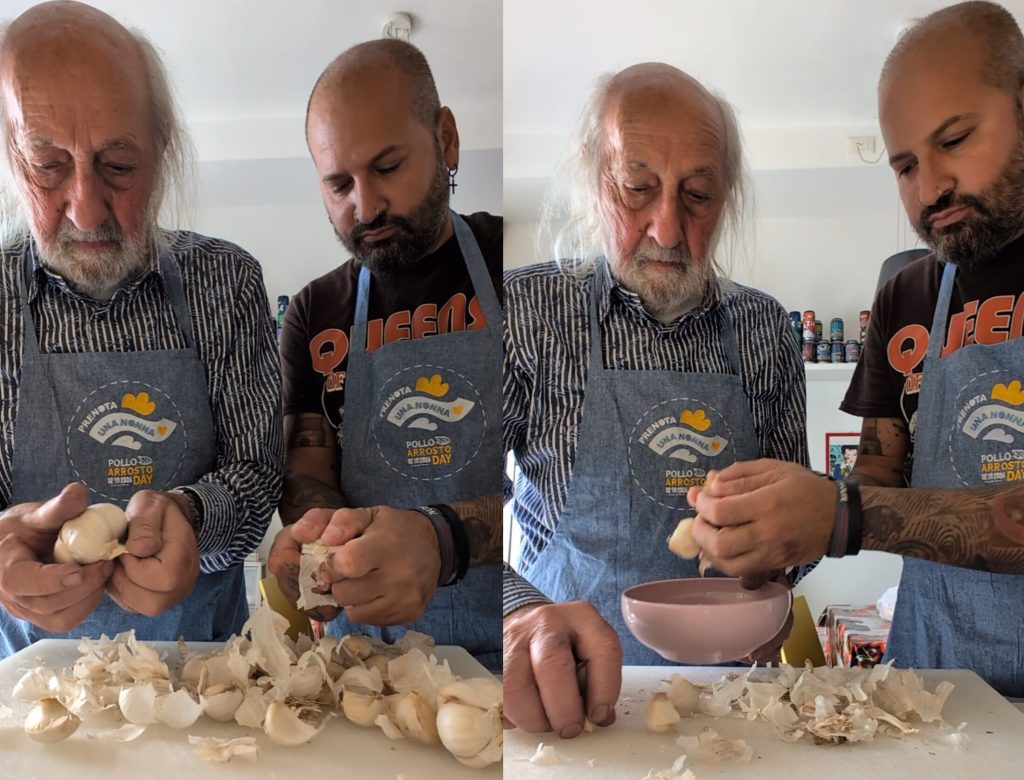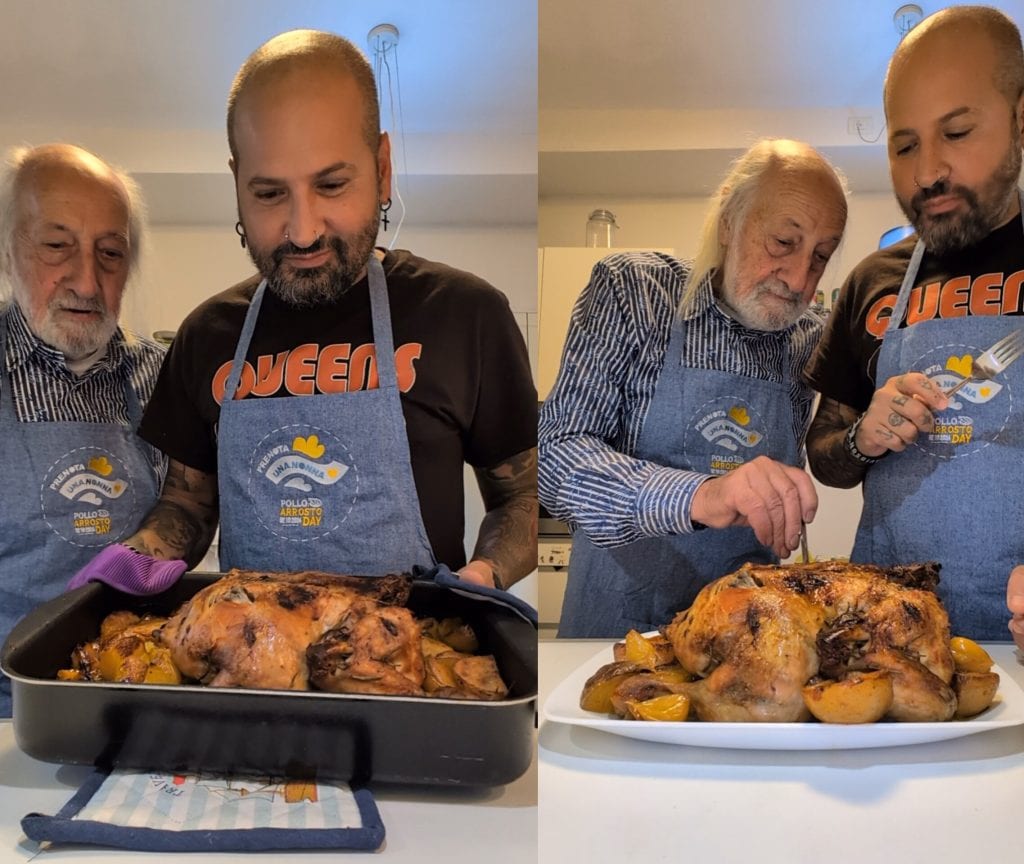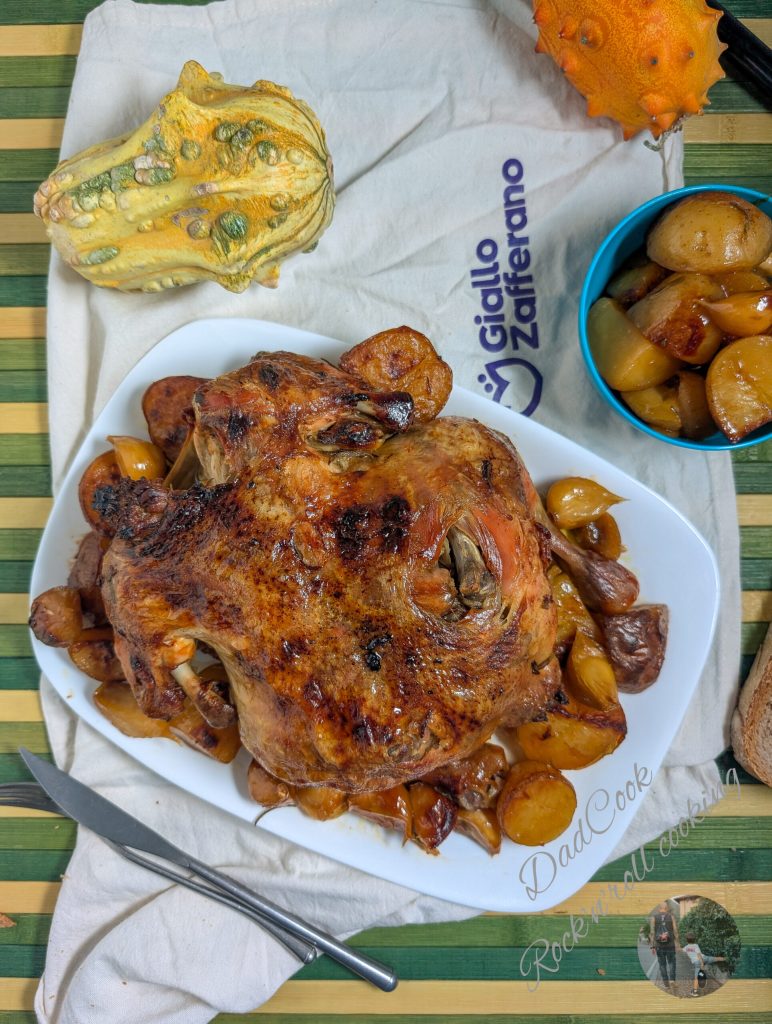Grandpa Giorgio, a man of few words but with a heart as big as a house, had a soft spot for his wife’s roast chicken. Every Sunday, lunch was a celebration: the inviting aroma wafting through the house, the crispy and golden skin, the tender and juicy meat… Grandpa Giorgio didn’t say much, but his eyes sparkled with pleasure with every bite. For years, he had watched his wife in the kitchen, admiring her skill in preparing that simple yet perfect dish. He never thought of trying his hand at cooking, leaving that realm to his beloved companion. But time passes, and strength wanes. One day, seeing his wife tired after preparing lunch, Grandpa Giorgio felt a surge of tenderness and decided to do something. “Dear,” he said with a slightly uncertain voice, “show me how to make this chicken. Maybe next time I’ll do it myself.” The wife, surprised but happy, welcomed him into the kitchen with a smile. Thus began an afternoon of apprenticeship, filled with laughter, a few small mistakes, and lots of camaraderie. Grandpa Giorgio, with his proverbial patience, followed every instruction, memorizing every gesture. The following Sunday, with a bit of anxiety but a lot of determination, Grandpa Giorgio got to work. The kitchen filled with familiar aromas, and soon a golden and inviting chicken took pride of place on the table. The family, curious, approached to taste it. A silence full of expectation, then the first enthusiastic comments: “Grandpa, it’s delicious!” It’s just like Grandma’s! Grandpa Giorgio, beaming, sat down at the table. His wife, with teary eyes, squeezed his hand. “Well done, Giorgio,” she said with a smile. “You did a great job.” From that day on, Sunday roast chicken became Grandpa Giorgio’s dish. It wasn’t perfect like his wife’s, but it had a special flavor, made of love and dedication. And every time the family gathered around that chicken, they felt the warmth of an even stronger bond. Grandpa Giorgio hadn’t become a great chef, but he had learned something much more important: the art of taking care of the people he loved, even with a simple gesture like preparing their favorite dish. And in the end, the perfection wasn’t in the chicken itself, but in the love that cooked it.

- Difficulty: Very Easy
- Cost: Very Affordable
- Rest time: 15 Minutes
- Preparation time: 20 Minutes
- Portions: 4
- Cooking methods: Oven, Stove
- Cuisine: Italian
- Seasonality: Fall, Winter and Spring, All Seasons
- Energy 354.26 (Kcal)
- Carbohydrates 2.74 (g) of which sugars 0.21 (g)
- Proteins 35.63 (g)
- Fat 22.45 (g) of which saturated 8.29 (g)of which unsaturated 13.81 (g)
- Fibers 0.31 (g)
- Sodium 294.31 (mg)
Indicative values for a portion of 310 g processed in an automated way starting from the nutritional information available on the CREA* and FoodData Central** databases. It is not food and / or nutritional advice.
* CREATES Food and Nutrition Research Center: https://www.crea.gov.it/alimenti-e-nutrizione https://www.alimentinutrizione.it ** U.S. Department of Agriculture, Agricultural Research Service. FoodData Central, 2019. https://fdc.nal.usda.gov
Ingredients
- 1 chicken (Whole)
- 40 cloves garlic
- 1 ⅓ cups light beer
- 1 ⅔ cups vegetable broth
- 2.2 lbs potatoes (Yukon Gold)
- 4 sprigs rosemary
- 30 leaves butter
- to taste sweet paprika
- 1 pinch black pepper
- to taste salt
- 1 drizzle extra virgin olive oil
Tools
- 1 Casserole
- 1 Baking Dish
Steps
To prepare the chicken with 40 garlic cloves, we started by cleaning the garlic. We separated all the heads into cloves, but without peeling them, as they need to cook with their “skin” (i.e., the peel). Once we had the necessary 40 cloves, we set them aside for the moment. Additionally, to ensure even and optimal cooking, we selected garlic cloves of similar sizes, discarding those that were too small or too large.

After preparing the garlic, we moved on to the potatoes. We cut them into medium-sized wedges, about 4 per potato, without removing the peel. We decided to keep it for a more rustic and earthy flavor, and to achieve an even crispier crust that contrasts with the soft interior. Once cut, we transferred them to a container and let them marinate for about half an hour with paprika, salt, fresh rosemary needles, and extra virgin olive oil.

Next, we focused on the chicken. After drying it with paper towels, we stuffed it with a few rosemary sprigs and a few garlic cloves inside the cavity. If we want to further flavor the meat, we can insert a few garlic cloves under the skin on the chicken breast. After stuffing it properly, we coated it with extra virgin olive oil and browned it on both sides in a casserole (oval in this case) along with the remaining 32 garlic cloves (40 total – 8 already used) and more rosemary.

Once the chicken has taken on a nice golden color on all sides, it’s time to deglaze with the beer. Pour the cold beer into the casserole, being careful of splashes. Let it simmer over medium heat without a lid, allowing the alcohol to completely evaporate. You’ll notice that the sauce will start to reduce and thicken, enveloping the chicken and garlic cloves with an enticing aroma. This step is crucial for removing the bitterness of the beer and concentrating the flavors, creating a flavorful base for oven cooking.

At this point, we add the hot broth to cover about half of the chicken in the casserole. Cover with a lid and let it cook on low heat for 30-40 minutes. During cooking, periodically baste the chicken on the surface with the cooking broth using a ladle. Be careful not to burn yourself with the hot steam when lifting the lid. This step is essential to ensure that the chicken meat becomes even more tender, resulting in a succulent and flavorful dish upon tasting.

After the necessary time, about 30-40 minutes, and when the broth has reduced to about half its initial volume, turn off the heat. With the help of two ladles or a slotted spoon, gently lift the chicken from the casserole and place it in a baking dish suitable for oven cooking. Make sure to transfer the cooked garlic cloves to the baking dish as well, as they will release additional flavor during oven cooking. Arrange all the potatoes you cut and marinated earlier around the chicken, distributing them evenly. Place everything in the preheated oven at 350°F (static or fan) and cook for another 30-40 minutes or until the chicken is well browned and the potatoes are tender and slightly crispy.

To conclude the recipe for chicken with 40 garlic cloves, about 10 minutes before the end of cooking, remove the baking dish from the oven. With the help of a brush, gently brush the chicken with melted butter, distributing it evenly over the surface and sides. This step will make the chicken skin even more crispy and golden, irresistibly inviting. Return the baking dish to the oven, this time setting the grill mode at 390-430°F (the temperature may vary slightly depending on the oven), and cook for another 5-10 minutes or until the skin is well browned and crispy.

Our delicious chicken with 40 garlic cloves, perfectly cooked with its golden potatoes, is finally ready to be enjoyed! But before diving in with forks, let’s give it a well-deserved rest of about ten minutes. This short interval will allow the juices to redistribute within the meat, ensuring an even more intense and succulent flavor with every bite. Additionally, the rest will help the skin firm up, making it even crispier and more delicious.

In the meantime, we can set the table, preparing it carefully to make this moment even more special. Let’s light some candles, play some nice background music and prepare to share this feast of flavors with our beloved grandparents. The aroma of roasted garlic and rosemary will fill the room, creating a warm and welcoming atmosphere, perfect for celebrating the love and gratitude we feel for them. Enjoy your meal, everyone!

Storage:
In the refrigerator: Leftover roast chicken can be stored in the refrigerator, in an airtight container, for 3-4 days.
In the freezer: For longer storage, you can freeze the chicken, already portioned, in freezer-safe bags. It will keep for about 2-3 months.
Tips:
Choice of garlic: Use fresh and high-quality garlic. If you prefer a less intense flavor, you can reduce the amount of garlic or use garlic with the skin. Cooking: Slow cooking at low temperature allows the garlic to caramelize and release all its aroma without burning. Check the chicken’s doneness by inserting a skewer into the thickest part of the thigh: the juices should run clear.
Leftover Uses:
Leftover chicken can be used to make salads, sandwiches, cold pasta dishes, or other tasty recipes.
Notes: This recipe is perfect for Grandparents’ Day, but it can be prepared for any special occasion or even for a simple family dinner. The chicken with 40 garlic cloves is a versatile dish that goes well with various side dishes, such as roasted potatoes, seasonal vegetables, or fresh salad.
Variations:
Lemon and rosemary chicken: Add lemon zest and juice to the sauce for a touch of freshness.
Herb chicken: Replace rosemary with a mix of herbs like thyme, sage, and oregano.
Spicy chicken: Add a fresh or dried chili to the sauce for a touch of heat.
Spicy chicken: Add a fresh or dried chili to the sauce for a touch of heat.
Remember:
Cooking is an act of love. Experiment, customize the recipe, and most importantly, have fun cooking!
Wine pairing for chicken with 40 garlic cloves:
Pairing the right wine with chicken with 40 garlic cloves might seem challenging due to the intense aroma of the garlic, but in reality, the slow and gentle cooking makes it surprisingly versatile.
Here are some interesting options:
White Wines:
Vermentino: A fresh and mineral white wine, with notes of citrus and white flowers, that balances the aroma of garlic and cleanses the palate. Fiano di Avellino: A structured white wine, with notes of ripe fruit and honey, that pairs well with the richness of the chicken and roasted garlic. Greco di Tufo: A volcanic white wine, with mineral notes and hints of aromatic herbs, that creates an interesting contrast with the sweetness of caramelized garlic.
Rosé Wines:
Cerasuolo d’Abruzzo: A full-bodied and structured rosé, with notes of red fruits and spices, that accompanies the complexity of the dish well. Chiaretto del Garda: A fresh and fruity rosé, with notes of strawberry and citrus, that refreshes the palate and contrasts the richness of the garlic.
Red Wines:
Barbera d’Alba: A young and fruity red wine, with soft tannins, that pairs well with white meat and garlic without overpowering the dish. Dolcetto d’Alba: A lively and juicy red wine, with notes of red fruits and spices, that creates a pleasant contrast with the sweetness of garlic.
General Tips:
Avoid overly tannic or oaky wines, which could clash with the aroma of garlic.
Choose wines with good acidity, which cleanse the palate and balance the richness of the dish.
Consider the side dishes that will accompany the chicken in choosing the wine.
Ultimately, the choice of wine depends on your personal tastes and preferences. Don’t be afraid to experiment and find the perfect pairing for you!
Ultimately, the choice of wine depends on your personal tastes and preferences. Don’t be afraid to experiment and find the perfect pairing for you!
FAQ (Frequently Asked Questions)
Can I substitute fresh garlic with garlic powder or minced garlic?
Of course, you can substitute fresh garlic with garlic powder or minced garlic, but keep in mind that the flavor will be less intense and slightly different. Fresh garlic, especially when roasted slowly, develops a sweet and caramelized aroma that garlic powder or minced garlic can’t fully replicate. If you decide to use garlic powder or minced garlic, I recommend reducing the amount compared to that indicated for fresh garlic, as the flavor is more concentrated. Start with about 1/4 of the amount of fresh garlic provided and add more to taste, tasting the sauce before cooking the chicken.
Remember that garlic powder tends to burn more easily than fresh garlic, so be careful not to cook the chicken at too high temperatures.

